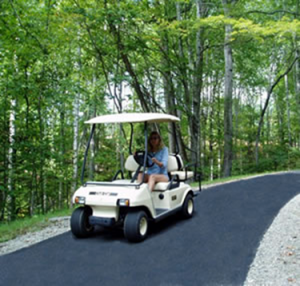 Because of the variations with each project, different factors must be evaluated in finalizing the pavement structure. This section will give the users some general guidelines and generic pavement structures for consideration.
Because of the variations with each project, different factors must be evaluated in finalizing the pavement structure. This section will give the users some general guidelines and generic pavement structures for consideration.
Design Considerations
When designing a pavement for recreation use several considerations must be made by the owner. First and foremost, how wide does the pavement need to be? For tennis and basketball courts, a standard or modified layout is known. For pathways used by walkers, bikers and golf carts, the width should be between 5 and 8 feet. A wider path would accommodate the occasional maintenance vehicle and in some cases emergency vehicles.
Many paths follow a long and often winding course. Where possible, the surface of the path should be sloped to follow the contour of the existing ground. This will allow water to flow off the surface and prevent ponding.
Drainage
Two of the most important considerations in designing a pavement are traffic and drainage. For recreation use pavements, the traffic loadings are very small and neglible. Drainage impacts pavement performance when the subgrade materials and pavement layer materials are saturated and loose strength. Even on recreational use pavements, ponding water can damage the AC over time. Additionally, if a pavement is subjected to heavy loads and the subgrade is saturated, then failure can occur. Water that falls on the pavement surface must be drained to the edges or ditches. Water penetrates the pavement from the surface, infiltrates from the sides of the pavement, or rises from under the pavement should not be allowed to compromise the overall strength.
To account for surface water drainage, it is important that the path be constructed with a cross slope. Typically, the path is sloped to follow the contour of the ground. However, this may vary depending on the existing ground. For courts, very little slope is desired. However, it is important a small slope exists and no low spots in the final surface are present to prevent ponding.
Subgrade Type and Strength
The subgrade type and strength will influence the overall pavement structure. Prior to construction of the path or court, all of the top soil should be removed. Additional soil should be removed to accommodate the final pavement.
Once the top soil and additional soil is removed, the subgrade must be compacted with a roller.
The final step with the subgrade is treating the area with a soil sterilant. This will keep vegetation from growing through the pavement.
Traffic
Non-motorized vehicles, golf carts and the occasional maintenance truck is the primary traffic on most paths. These vehicles do not normally cause pavement damage. At times, a heavy truck may use the path. These heavy trucks could damage a path, especially if the subgrade is saturated. If these trucks must use the path, it is recommended to wait until a time of the year when the pavement and soil is either dry or frozen.
Pavement Structure and Materials
The pavement structure and materials are common across subgrade strengths and construction approaches. Some projects will use full-depth asphalt (i.e., asphalt placed directly on compacted subgrade) and some will use an aggregate base placed on compacted subgrade. The aggregate base will be covered with one or more layers of asphalt. The table below is the minimum pavement designs. Each layer is the compacted thickness. At no time should less than 4 inches of an aggregate subbase layer be used. In addition, most owners will not have a soil strength test performed on their subgrade. Therefore, for silty and clayey soils, a medium or weak subgrade should be assumed. For sandy and gravelly/rocky subgrade, a strong or medium subgrade should be assumed.
Table 1 – Full-Depth Asphalt Pavement
| Pavement Layer | Materials Recommended and Thicknesses | ||
Strong Subgrade (Design CBR > 10) | Medium Subgrade (Design CBR 6 to 10) | Weak Subgrade (Design CBR 3 to 6) | |
| Surface | 1” SM-9.5 | 1” SM-9.5 | 1” SM-9.5 |
| Base | 2” SM-12.5 or SM-9.5 | 2” SM-12.5 or SM-9.5 | 2” SM-12.5 or SM-9.5 |
| Subbase | No Aggregate Subbase | ||
Table 2 –Asphalt with Aggregate Sub-Base Pavement
| Pavement Layer | Materials Recommended and Thicknesses | ||
Strong Subgrade (Design CBR > 10) | Medium Subgrade (Design CBR 6 to 10) | Weak Subgrade (Design CBR 3 to 6) | |
| Surface | 2” SM-9.5 | 2” SM-9.5 | 2” SM-9.5 |
| Base | No Base Asphalt Needed | ||
| Subbase | 4” 21B | 4” 21B | 6” 21B |
Notes:
- Design CBR is defined as 2/3 of the soaked CBR value.
- VDOT Specifications for SM-4.75, SM-9.0, SM-9.5, and SM-12.5 can be found in Section 211 of the VDOT, Road and Bridges Specification Book.
- VDOT Specifications for 21B can be found in Section 208 of the VDOT, Road and Bridges Specification Book.
References
- 2007 VDOT, Road and Bridges Specifications
- VDOT Special Provisions to the 2007, Road and Bridges Specifications
- VAA Pavement Design Manual
